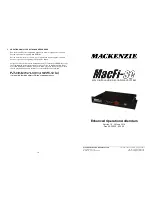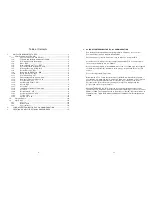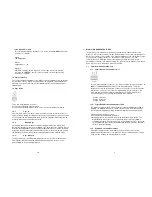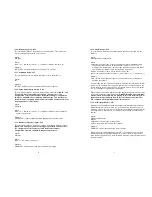
8
1.1.16. Record- REC
This command is to used to record new messages or replace existing messages
in the MacFi-se . The Record command can be open ended, meaning that the
recording is started with this command but must be stopped using the Stop
command or the time constraint.
Syntax;
REC
msgnumber,delay,time
Where;
msgnumber
= the message location to be played<1-99>
delay
= the number of seconds to delay before starting the record process<1-
99>
time
is the duration of recording time (+) 1 thru 99 for seconds or (-) 1 thru 99 for
minutes.
Example;
REC8,10,-4<CR> will record into message location eight after a 10 second
delay for 4 minutes.
Disabled messages may be overwritten with the Record command. If the
system runs out of memory during the record process prior to the end of the
audio message, the system will stop recording and the save whatever portion of
the message was recorded. When the record command is received, any
currently playing message will be stopped. The audio output is routed from the
audio input, so that the user will hear the message being recorded. Immediately
after receiving this command, the system will erase the message number called
out in the command string. There is no recourse once the message is erased,
the data associated with it is freed for other messages to use.
If no message number is placed after the command, the incoming audio
message will be placed in the first available memory location. If there is no
memory slot available, the system will reject the record command. When no
messages are in memory the system defaults to message # 1. Because the
protocol requires that bytes two and three proceed byte one, REC<CR> will
default to a one second delay time, and will allow the user to record until the end
of memory. Because of the tasks the system must perform after receiving this
command, the device cannot start the recording process immediately. A one
second delay must be inserted after the command is received before the system
can start recording audio. Any audio input to the system prior to the device
being ready to record is at risk of being cutoff.
1.1.17. Reset- RST
This command causes a warm reset of the MacFi-se system.
Example;
RST<CR>
1.1.18.
5
1.1.6. Restore Default Configuration - CFG
This command restores the user configurable settings such as PAS and PLS to
their default setting and sets baud rate to 9600.
Syntax;
CFG
Example;
CFG<CR> will trigger Y/N confirmation question in order to restore the default
configuration.
1.1.7. Message Directory Listing - DIR
The configuration of each memory location will be displayed to the user when
this command is issued. The display will show each of the 99 available message
locations with either a number in the location, "XX" in the location or a "D" in
front of the message number.
Example;
DIR<CR>
If a number is in the location, the message is valid and available for automatic
playback. If an "XX" is in the location, the message is currently blank, and the
location is available to be recorded into. If there is a "D" in front of the message
number, a message exists, but it is disabled and not available for playback.
1.1.8. Delete Message - DEL
This command will delete a message from memory.
Syntax;
DEL
msgnumber
Where;
msgnumber
= 1 - 99
Example;
DEL5<CR> deletes message number 5.
1.1.9. Download an MPEG File - DLD
This command configures the MacFi-se to receive a MPEG 1 Layer 1, 2 or 3
(MP3) file via YMODEM. The maximum MPEG data rate supported is 128kbps.
Syntax;
DLDmsgnumber
Where;
msgnumber
= 1 - 99 or if left blank, downloaded file will be placed in the next
empty memory location.
Example;
DLD2<CR> initiates download sequence for message 2. After command is
executed, a YMODEM transfer of the file should also be initiated on the
controller or computer.






